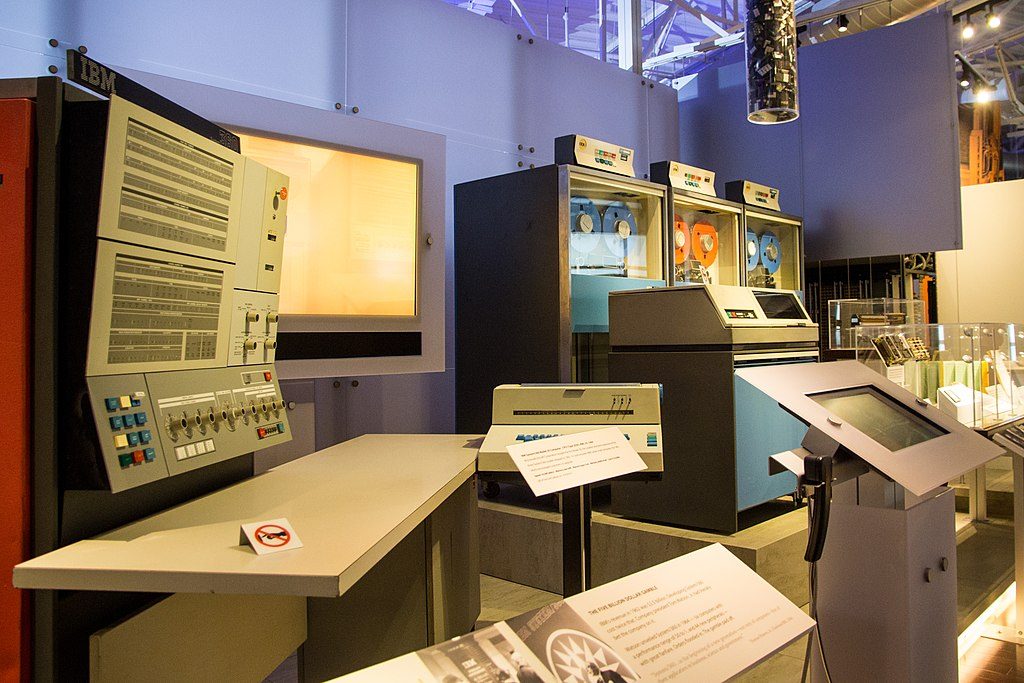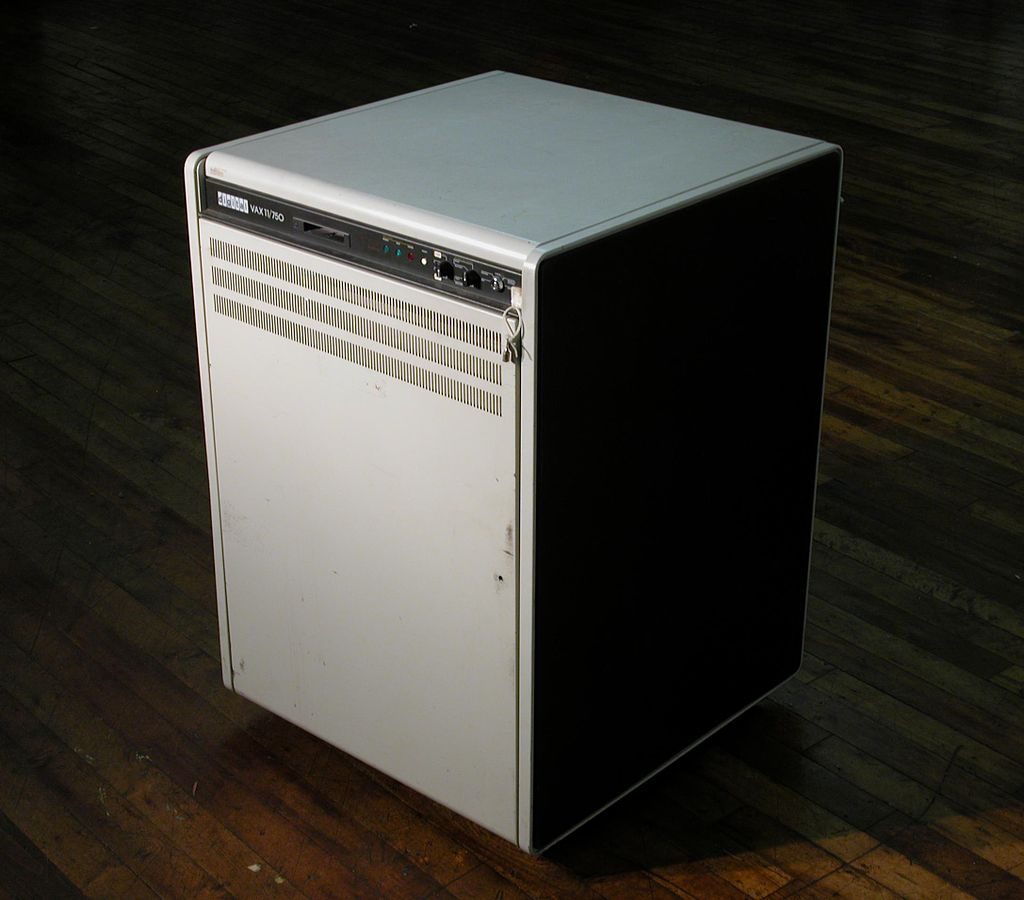My very first computer was a mainframe IBM 360. Well, it wasn’t mine, nobody owned a computer back in the seventies. The 360 was the mainframe available at the university where I studied Electronics Engineering, the University of Palermo, in Italy. It ran under an operating system that was called DOS, an acronym for Disk Operating System.

IBM System-360 Model 30 at Computer History Museum, Mountain View
At that time, personal computers did not exist yet, so I learned how to program by using piles of punch cards. It wasn’t until the eighties that I was able to put my hands on a much smaller scale computer, capable of interactions through a video screen. Those were the times of the Commodore computers, the first Apple, and the Sinclair.
In the mean time I started working for a big telecommunication company, so I started also putting my hands on minicomputers, like the VAX 750. The OS of choice, at the time, was VMS first (Virtual Memory System), and then UNIX (Uniplexed Information and Computing Service). UNIX was a great Operating System, with an innovative way of seeing all the devices connected to it (everything is a file in UNIX). Using UNIX for all my needs as a programmer for telecommunication systems was really fun and easy and I kept growing fond of it day by day.

VAX-11-750
And, finally, the IBM personal computer arrived and, with that, MS-DOS.
MS-DOS was an OS similar to UNIX, in certain ways, but much more limited in capabilities and cumbersome to use to type commands. Having the habit of using UNIX, MS-DOS wasn’t exactly my ideal of Operating System.

IBM 5150 PC
Finally the first graphical interfaces started to appear. They were actual programs running on top of UNIX and they were very efficient and easy to use.
And then, the first graphical interfaces started appearing also on Apple and IBM PCs. That was the time when the first IBM PC compatible computer entered my home. It was equipped with MS-DOS 5.0 and Windows 3.0.
With that PC, I learned how to make programs with graphical interfaces and the world of personal computing suddenly became much more interesting.
Also my work improved in that period of time. I moved to the USA and worked for a while for the AT&T Bell Labs. Later, AT&T Bell Labs let go its developmet branch and Lucent Technologies was born. There I soon started working on a new telecom system named Softswitch. Softswitch was heavily based on a new Operanting System called Linux, that looked practically identical to UNIX, at least from the high level point of view. I learned that Linux could be easily and freely installed on a PC and so, one day, I took an old machine that I had around at home, downloaded Fedora Core 8, and installed it on that old PC.
I was really amazed when I found that Fedora was able to run really fast on that old system, and that had so many choices of graphical interfaces, many resembling those that I was used to in the UNIX environment. I also discovered that Fedora repositories were full of free applications, many of them a perfect replacement of those applications I daily used in the Windows environment.
So, one day, I decided to switch from MS Windows to the Linux distro Fedora and see if I could use it for day to day tasks at home without relying on Windows apps anymore. It was a success and, within a few months, I completely abandoned Windows in favor of Fedora-Linux, never to return anymore to Microsoft and its heavy to run applications that needed newer and more powerful machines every year. The one and only application that I wasn’t able to replace was the one to prepare my tax returns. But for that, I just used a virtual machine under Linux running Windows in it. For anything else, I used the Fedora distro of Linux.
Thank you Linus Torvalds for having created such a viable Operating System!
Today I use Linux for everything (besides the tax prep app). I use it for programming personal applications, to handle the family budget, to play games, to handle my multimedia collection of videos, music and pictures. I also use it to create my video contents that I periodically publish on YouTube under the brand eleneasy (I also have a companion site eleneasy.com, where I expand on the subjects I present on YouTube).
From time to time I also like to experiment with different Linux distros. I tried CentOS, Debian, Ubuntu and several others. However, no one operating system has ever been able to provide me with what Fedora makes available. I like the cutting edge feel of Fedora: every time something new happens in the world of Linux, Fedora is always the first place where you see it happen.
But, there is always a but…
Over time, the computer at home became for me more and more a tool to use, not a programming environment like the one I use at work. And because of that I started having doubts about the cutting edge thing. In fact, from time to time, I found myself spending some time to fix things that stopped working, or at least stopped working the way they did before. So, I started thinking to use a different distro that would give me more stability, more consistency over time. And so one day I decided to move to Ubuntu, which provide a Long Term Support, or LTS, kind of release, which is basically upgraded only to fix bugs, but remains in general constant for a few years.
I took the decision to move to Ubuntu LTS when the current release was about to be replaced with a new one in a one year time frame. But I thought: what the heck, I will install the current one and upgrade to the next once it comes out, and then I will be done with upgrades for another 4 years.
What a mistake that was.
When I upgraded Ubuntu to the new LTS release, a lot of things started happening. Several programs refused to work in the new Release, others disappeared. And some of them where those I relied upon to do my work with 3D printing, blogs, electronics design, and video making.
I tried to resist for a while, working hard to make those programs work again. For some I succeeded, but for others I had to admit that they might have not worked anymore unless, probably, I reinstalled Ubuntu from scratch.
What a delusion!!!
And so, since my last resort was to reinstall, I decided to go back to Fedora, currently on version 29. As soon as I did that, I regained control of all those programs I had lost and, for some of them, I also gained some new features and a much needed higher execution speed. I promised myself that I will never again move away from Fedora. Little glitches on every new release are, at the end, easy to fix and live with. But the bad Ubuntu experience… never again.
I have to say that the choice of using Ubuntu was not an easy one. When I did that, I tested several distros to see how they behaved with the applications I needed to use the most. Ubuntu was the definitive winner and, probably, if I wasn’t the power user I am, Ubuntu would have been just fine for me. But, in my terms, I like and need continuous innovation that doesn’t break. Little glitches I can handle. And so my best option remains Fedora.
Not to say that Ubuntu is a bad distro. Not at all. Ubuntu works just fine for normal users, those that do not have a good understanding of what happens behind the scenes of an OS and so are happy to use a system that takes away all the burdens of acting as a system administrator more often than they would like. Ubuntu is perfect for the simplified way of installing it, for the automation in software updates, and a lot of other things.
However, Fedora is the best solution for my needs. I like the cutting edge side of the distro, providing always the latest capabilities (that sometimes need a little tweaking to make them work the way you want). After all, Fedora is just that, a trampoline platform for testing new technology that later is incorporated in the Red Hat distro, which is basically the commercial edition of Fedora, kind of equivalent to the LTS for Ubuntu.
But Fedora works for me as is, and I made the promise to myself to never cheating her again for another distro somewhat less capable of her.
And you? What Operating System runs on your personal computer, being it a desktop or a laptop, or whatever else? I’d like to make a little poll about it to see what kind of OS is used by my followers. Please drop me a small comment, maybe with just the name of the OS you use, if you don’t want to spend much time. It could help me for better aiming future posts on this site. I suspect the most people uses Windows, followed by OSX and Linux. And then there are the Chromebooks, and FreeBSD, and several others. Which one is yours?




Leave a Reply